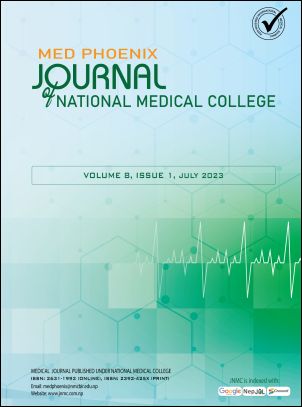Analysis of Intrapartum Cardiotocography Findings in Labour, its Correlation with Umbilical Arterial Blood pH and Neonatal Outcome
DOI:
https://doi.org/10.3126/medphoenix.v8i1.52810Keywords:
Intrapartum CTG, Neonatal Outcome, Umbilical Artery pHAbstract
Background: Cardiotocography (CTG) is being used in all labouring women to detect intrapartum hypoxemia which further requires confirmatory tests. But in a setting where these facilities are not available, umbilical artery pH analysis can help not only in identifying neonates with intrapartum hypoxemia but can also help in anticipating neonatal adverse outcomes. The aim of the study was to analyse intrapartum cardiotocography and its correlation with umbilical artery pH and neonatal outcome.
Methods: Total of 317 consecutive single, term, labouring women were included in the present study. After taking CTG, it was classified into normal, non-reassuring and abnormal groups according to National Institute of Clinical Excellence (NICE) guideline 2017. At birth umbilical cord arterial blood was taken to detect neonatal hypoxemia. At the same time, APGAR score at 5 minute of birth, NICU admission and neonatal mortality was also recorded. Neonates with umbilical artery blood pH of ≤7.2 were considered as asphyxiated.
Results: Among 317 women 48.8% had normal CTG, 35% had non-reassuring and 15.4% had abnormal CTG. APGAR score was found to be <7 in 17.3%, and same number of neonates had NICU admission. Out of 113 non-reassuring CTG, 5.9% had acidosis. This number was much higher in abnormal CTG group where 11% had acidosis. There were 6 neonatal mortalities. A statistically significant association was found between intrapartum CTG and umbilical artery pH and neonatal outcomes.
Conclusion: Cardiotocography is an effective screening tool that is routinely used in all labouring women for screening of fetal hypoxia. By doing that timely intervention can be under taken to avoid neonatal morbidity and mortality.
Downloads
Downloads
Published
How to Cite
Issue
Section
License
Copyright (c) 2023 Med Phoenix

This work is licensed under a Creative Commons Attribution 4.0 International License.
Copyright on any research article is transferred in full to MED PHOENIX upon publication. The copyright transfer includes the right to reproduce and distribute the article in any form of reproduction (printing, electronic media or any other form).
© MEDPHOENIX
![]()
Articles in the MED PHOENIX are Open Access articles published under the Creative Commons CC BY License (https://creativecommons.org/licenses/by/4.0/). This license permits use, distribution and reproduction in any medium, provided the original work is properly cited.




